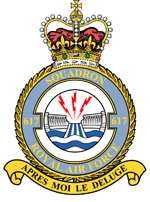617 Squadron: Difference between revisions
Jump to navigation
Jump to search

imported>Howard C. Berkowitz No edit summary |
John Leach (talk | contribs) (reduced to a brief introduction which has itself been checked for accuracy; expansion is needed by reference to reliable sources) |
||
| (5 intermediate revisions by one other user not shown) | |||
| Line 1: | Line 1: | ||
{{subpages}} | {{subpages}} | ||
[[Image:617 Squadron Insignia.jpg|right|250px|thumb|617 Squadron insignia showing a breached dam.]] | |||
'''617 Squadron | '''617 Squadron''' of the [[Royal Air Force]] was formed on 21 March 1943 at RAF Scampton in [[Lincolnshire]] for the famous [[Dambusters Raid]]. | ||
==References== | ==References== | ||
{{reflist}} | {{reflist}} | ||
[[Category:Reviewed Passed if Improved]] | |||
Latest revision as of 16:16, 12 March 2024
617 Squadron of the Royal Air Force was formed on 21 March 1943 at RAF Scampton in Lincolnshire for the famous Dambusters Raid.
